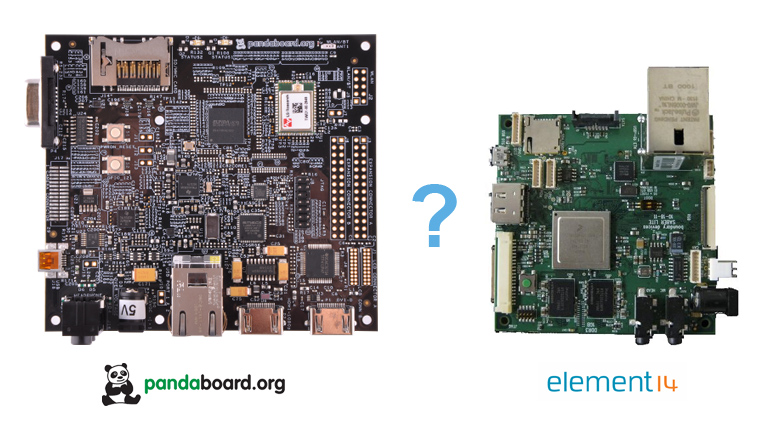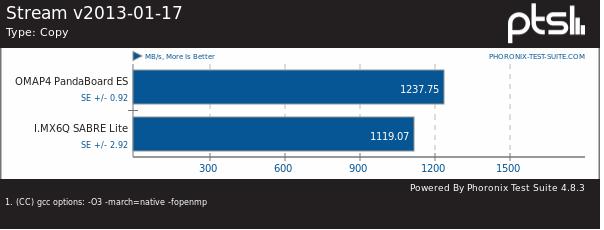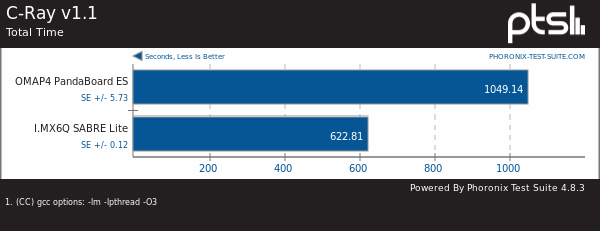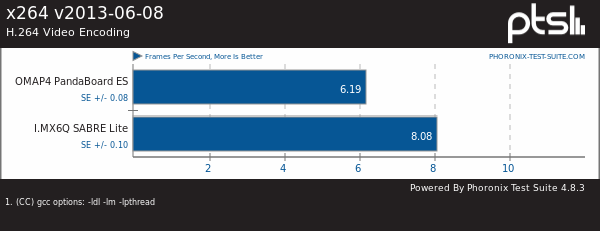Test: IMX6 and OMAP4 performance comparison

In this article, we will share the results of testing the performance of two ARM-based systems with the Cortex-A9 core - OMAP4 PandaBoard ES and i.MX6Q SABER Lite (dev kit of the online community element14).
A complete list of the characteristics of these development kits can be found at the links above, and in this article we will only indicate those distinctive features that directly affect the performance of processor and memory tests.
OMAP4 PandaBoard ES Rev B1 | i.MX6Q SABER Lite | |
CPU | TI OMAP4460 | Freescale i.MX 6Q (Prototype Samples) |
Core | Cortex-A9 | Cortex-A9 |
Number of Cores | 2 | four |
Maximum core clock frequency | 1.20 GHz | 996 MHz |
Cache | L1 32KB I-Cache 32-KB D-Cache | L1 32KB I-Cache 32-KB D-Cache |
External sdram | 1GB, dual-channel DDR2 @ 400MHz | 1 GB, 64-bit wide DDR3 @ 532MHz |
Sd card | Transcend 4GB | Transcend 4GB |
We chose the Linaro distribution as the base system for testing.
Initially we planned to conduct tests on Linaro 13.09 with the Linux 3.12 kernel, while for the SABER Lite we used the vanilla kernel, which we compiled ourselves, because i.MX6 support was implemented only in Linaro 12.04. However, in this configuration, in all CPU performance tests, SABER Lite was far ahead of PandaBoard (by tens of percent), and our test results were very different from the data published on openbenchmarking.org for PandaBoard ( 1 , 2 ).
Then we tried to conduct tests on Linaro 12.04, but the situation repeated itself, this time, perhaps this was due to the support of cpufreq in the Linaro 12.04 core for PandaBoard (for a detailed description see here ).
As a result, we chose the Linaro distribution on 12.08 for PandaBoard and Linaro on 12.04 for SABER Lite (both based on Ubuntu 12.04). The root file system of both the boards was replaced on the external SD card, the same memory card was used for the tests in turn. Phoronix Test Suite 4.8.3 (the latest version available at the start of the tests) was chosen as the test software for measuring performance.
Tests are mainly focused on analyzing CPU and memory performance. Comparing the results, it is necessary to take into account that the i.MX6Q has four cores, and the OMAP4460 has two, these cores on each of the processors operate at different frequencies. In addition, the development kits themselves have a different type of memory and frequency of its bus. Some tests are performed on only one core, so in the explanations we will indicate where the test is executed in one, and where - in several threads.
Here is a table with system information that is generated by the Phoronix Test Suite.
Let's start with the results of performance tests with external SDRAM-memory .

PandaBoard wins about 10% from SABER Lite. In principle, such a result (as a first approximation) allows you to compare the results of tests of processor performance without taking into account the effect of memory performance.
Below are the test results of the read speed from the file system located on the SD card.

In this test, taking into account the measurement error, both boards show the same results, which makes it possible to compare test results that require quite intensive work with the file system, for example, a test of application build time.
The OpenSSL test checks the RSA 4096-bit encryption speed in the openssl implementation, it runs as a single stream.

Given the frequency normalization, both systems show almost the same performance (0.8% in favor of SABER Lite).
C-Ray tests CPU performance on floating point calculations. This is a multi-threaded test (16 threads per core).

This test shows the scaling of results on the number of cores. Taking into account the normalization of the frequency and number of cores, as well as taking into account the measurement error, both systems show the same performance.
Below are the results of encoding audio and video data . The FLAC Audio Encoding and LAME MP3 Encoding tests are performed in one stream, the x264 test is multi-threaded.

Taking into account the normalization of the frequency PandaBoard shows 9% more performance compared to SABER Lite.

A similar situation with MP3 encoding: PandaBoard shows 3% better performance (including normalization) compared to SABER Lite.

Taking into account the normalization in frequency and number of cores, PandaBoard is approximately 30% ahead of SABER Lite.
The Timed MPlayer Compilation test analyzes the build time of the mplayer player, the build is performed by the compiler installed on the system (in our case, on both systems —gcc 4.6.3). The number of threads in the assembly is equal to the number of cores.

The expected result was the scaling of the results by the number of cores, but this dependence was not observed. On 4-core 1 GHz cores, the test is performed 6% slower than on 2 1.2 GHz. Apparently this is due to the fact that the speed of working with Flash memory was a bottleneck in this test.
Below we present the results of some tests of SciMark 2.0 implemented in C, these tests are performed on one core.



Taking into account the normalization of the frequency PandaBoard shows 15%, 0%, 40% more performance compared with SABER Lite.
According to the test results, the following can be noted:
In all tests, PandaBoard showed either higher or comparable performance compared to SABER Lite. In the two tests, the x264 encoding and the SciMark2.0 Dense LU Matrix Factorization results differed significantly (Timed MPlayer Compilation is not considered).
In general, it is possible to conclude that there is some advantage of the system based on the TI OMAP4460 processor (PandaBoard ES) within the specified configuration of software and hardware. More details about TI chips can be found on the website of the Promwad electronics design center: Texas Instruments microprocessors .
')
Source: https://habr.com/ru/post/209844/
All Articles
